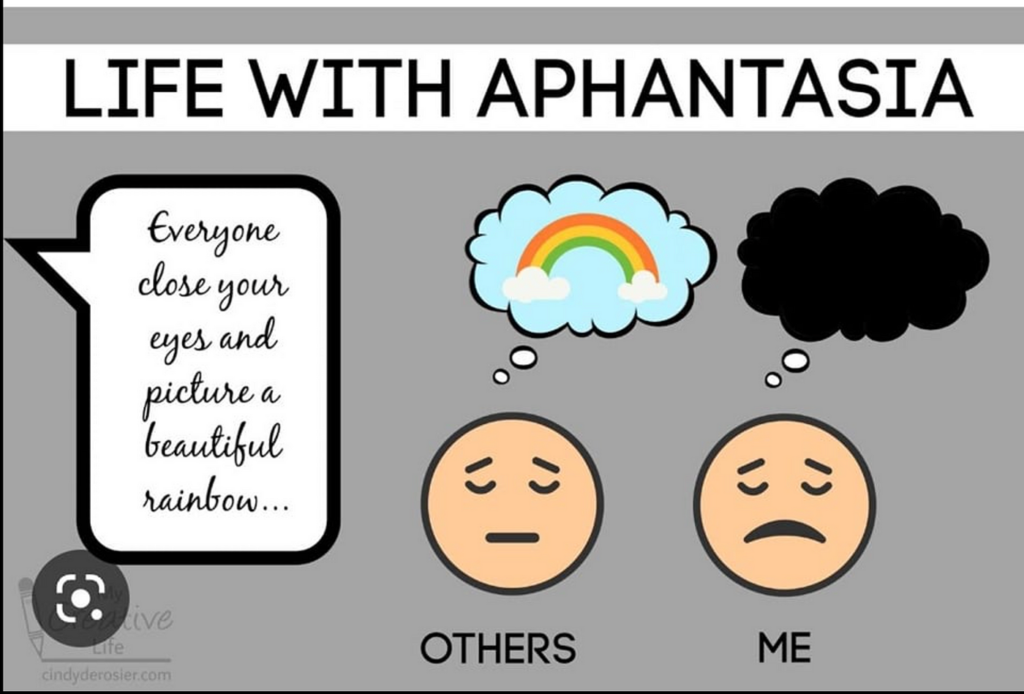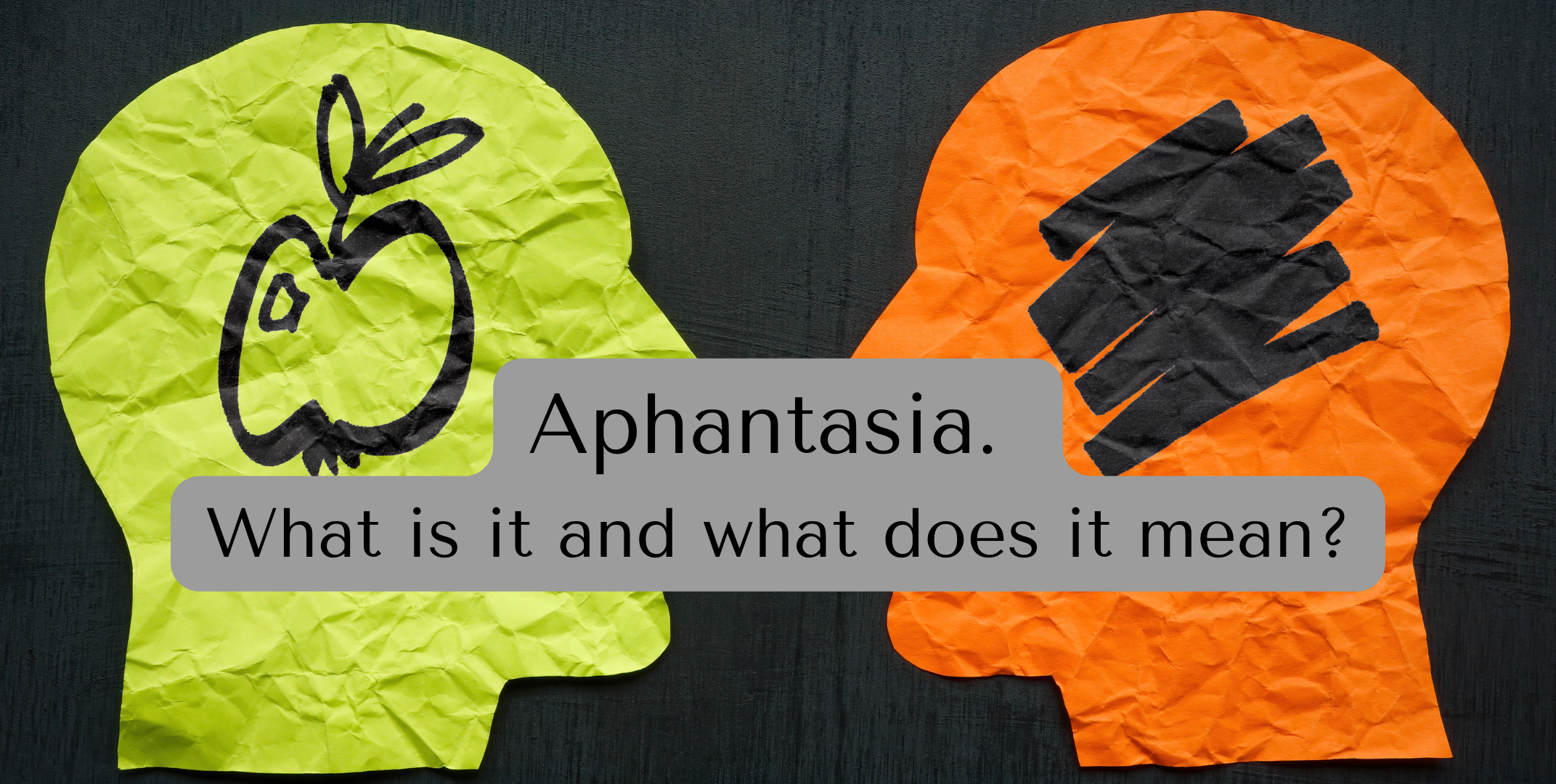By Maggie Giles
These are two questions I get a lot when I tell people that I have aphantasia.
Aphantasia is often described as a visual condition, when one lacks the mind’s eye and are unable to picture images in their head, but in reality, aphantasia is a multisensory condition and it’s on a spectrum.
Sometimes described as a “sixth sense”, Aristotle first coined this as “phantasia” (often translated to mean imagination); the “a” in a-phantasia denotes its absence. An estimated 3-5% of the population experience aphantasia, and another 10-15% are believed to experience the opposite, hyperphantasia (extremely vivid imagination).
As mentioned above, aphantasia is more than just visual. It can involve all your senses. People with aphantasia on average have reduced ability with other mental senses and approximately 26% of aphantasics have “a total absence of multi-sensory imagery.” This lack of all mental senses is sometimes called total aphantasia.

I personally have visual aphantasia, and I don’t find my other senses suffer nearly as much. While I could delve into the history and give you a background on the studies in aphantasia, the timeline would be a short one, as in modern days. The term wasn’t coined until 2009.
Since then, there have been studies done on aphantasia and the creation of the Aphantasia Network in 2015 has helped to bring awareness to it.
How do you know if you have aphantasia? While the science isn’t perfect, there is a way to figure it out.
Do you picture the scenery when you read? See your main character? Are you able to pull up an image in your mind and describe it? Then you don’t suffer from visual aphantasia. I, however, see nothing. It’s all dark up there when I try to picture something described to me.
What does this lack of visual imagination mean for an avid reader and published writer?
The short and sweet answer is that until recently, I didn’t realize it had any effect on me at all. Having never been a visual person, I guess I didn’t know what I was missing. However, I now realize that the way I remember or picture things is completely different than many others.
I never really understood when someone said a movie character didn’t line up to the image they’d imagined, or that they’d thought a certain scene in a book would play out aesthetically differently, but I never thought twice about it. I figured they just had their own idea of what they wanted to see. Later I realized that of course they did, but what I hadn’t understood was that they actually saw these ideas in their heads while they read along with the story.
I’ve been a huge reader and storyteller since I was a child. I never worried too much about the pictures I didn’t see in my head (of course not realizing this was abnormal!) and focused instead on the dialogue and plot that drew me in. Not mentally seeing has never affected the emotions I feel when reading or the intensity of a story.

As an author, I’ve been asked how this affects my writing process. Before my discovery of my aphantasia I never realized when I first started writing I rarely included descriptions. I didn’t care how the characters looked, how they dressed or what the room they were sitting in looked like. These things didn’t matter to me as a reader, so why would I make the connection when I started writing?
It wasn’t until I started getting early critique partners asking me how things looked. Oftentimes they wanted a series of descriptions to let them know what they as a reader were looking at. Not an unreasonable ask by any means, but something I truly struggled to grasp.
Now, I’ve worked harder to notice descriptions in prose and try to read each part more carefully. Although it still doesn’t paint a picture in my mind, I can still draw on the ideas to use as information when I read through the story.
This has also helped me with my own writing. Noticing how other authors tie in their descriptions and vivid detail has allowed me to take a lot of my “bare bones” drafts and weave in the color and scenery the story needs. It has helped me detach a bit from my condition and figure out how to ensure that my readers are seeing everything I want them to, even if I am ultimately unable to see it myself.
I make use of a lot of visual aids, such as Pinterest boards, to really help me describe what my character is looking at. Since I struggle to pull up the picture in my head, using a photograph or drawing has proven to add a lot more depth and detail to my descriptions.
Do I wish I had a visual imagination? Absolutely, I totally envy the idea that someone can picture exactly what is being described to them in their head. But I also remind myself that while I may have aphantasia, I have not allowed this to ruin my love of reading and writing. I still flock to the next book. I love to see on screen adaptations. And I will never tire of a good story.
If you want to learn more about aphantasia, I recommend visiting the Aphantasia Network at https://aphantasia.com/.


I’m so with you! I read an article on aphantasia this week, and realized that I create, rather than see/remember the visual aspects of my memories. As a writer, I’m definitely a dialogue girl and must work hard to include visual cues in my writing. Wild!
Thanks for sharing!! It’s definitely a very interesting topic and I am excited to see what else comes out about it. For now, all we can do is embrace our uniqueness and carry on!